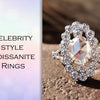
How Were Birthstones Chosen for Each Month?
Birthstones have become an integral part of their jewelry and accessories. They represent culture, tradition, and history, and every birthstone has been created with a unique meaning and symbolism. With a rich history of gemstones, consumers choose them based on their month, mood, and sign. Astrological stones and gems reflect a person's beliefs and personality, and every corner narrates special folklore. Diamondrensu has a diverse catalog of birthstones curated according to gem list of each month and crafted with care and attention.
Astrology stones and gems are often associated with prosperity, safety, good luck, and health. Astrologers believe that stones carry otherworldly or supernatural powers, given their biblical origin and century-old traditions. Seen as a unique love language, these are designed for gemstone enthusiasts and people who enjoy giving gifts. Their variety of colors, meanings, and symbols stand for love, sentiments, and appreciation. In modern traditions, every month consists of at least one stone, with a different backstory. Necklaces, pendants, rings, bracelets, earrings, or loose gems birthstones celebrate birth, culture, and tales passed down from generation to generation.
History of the Process
Every culture has its own story behind the formation of gemstones and their attributes. Multiple interpretations and sources indicate various origin stories, varying from culture to culture. Allotting a birthstone to each month does not seem to have a singular point. Scholars, scientists, and researchers have ruled out different possibilities, tales, and locations.
For some scholars, the origin of birthstones dates back to the Book of Exodus. The second book of the Bible follows the life of Aaron, a high priest in service during Moses' time. He carried a religious breastplate containing twelve jewels. All twelve gems had the names of Israel's twelve tribes engraved on them. If history is to be believed, the gem list of twelve stones were chipped from God's throne. Jewish historian Flavius Josephus claimed the breastplate carried supernatural elements. He also thought that wearing the astrological gemstones in their assigned month would bring good luck and miracles.
However, scientists and scholars drew unclear conclusions regarding the credibility of the breastplate. Some believed the tale, while others remained skeptical but could not find a more credible source.
Folklore Influence on the Decision
Folklore played a significant role in deciding the meaning and symbolism of astrological stones. According to legend, each month of the year represents a different stone. There are numerous tales regarding gemstones and their elements. Folktales believe that wearing jewels in their respective month, regardless of the style, design, or ornament, is therapeutic for the wearer. Putting on stones in their assigned month increases positivity, good luck, and health and heals your life.
January: Garnet
Cushion Cut Red Garnet with side Half Moon Moissanite Three Stone Ring
January's assigned birthstone is Garnet. It represents eternal friendships, unbreakable bonds, and faith. The meaning behind this stone makes it a personal and sentimental present to celebrate your relationship with your friends. Derived from the Latin word 'granatum,' meaning seed, garnet looks like a pomegranate seed. According to scholars, centuries ago, Egyptians used to wear garnet jewelry.
February: Amethyst
In folklore, ancient Greeks and Romans used amethyst to grow stronger and resist the power of Bacchus, the God of wine. They believed amethyst would give them the powers of sharp thinking, clarity, and strong will. Assigned to February, this stone is one of the main characters in every legend, tale, myth, tradition, and religious story.
March: Aquamarine
4.94 TCW Aquamarine Radiant Unique and Lovely Micro Pave Engagement Ring
March's birthstone, Aquamarine, is derived from the Latin words' aqua,' meaning water, and 'marina,' which means water bodies. Per folktales, sailors used to travel with this stone for good luck, safety, and an obstacle-free journey. Aquamarine has a unique color pattern. Its general shade is light, with green, blue, or blue-green hues. The lively and calm color scheme is also associated with the onset of summer and spring. Also, royal families wore jewelry with a purple amethyst stone, representing royalty.
April: Diamond
Considered the queen of gemstones, the Diamond is April's birthstone. People in ancient times associated it with solid relationships, mutual trust, and inner peace. Diamonds also represent a balanced lifestyle, clear decisions, and eternal love.
May: Emerald
Emerald Gemstone Engagement Ring, 1.81 CT Emerald Cut Halo Wedding Ring, May Birthstone Ring
Folklore considers emeralds the gemstone of rebirth, better foresight, incredible luck, large fortune, and everlasting youthfulness. Derived from the Greek word 'smaragdus,' which means green, emerald's origin dates back to 300-350 BC Egypt.
June: Alexandrite
Unlike other stones, Alexandrite joined the party late. Where most gemstones were found during biblical times or the Roman or Greek empires, Alexandrite was discovered in 1831. Discovered in Russia, this stone was named after Czar Alexander II. Its beauty lies in its ability to switch colors green during the day and under fluorescent light, but purple during the night time.
July: Ruby
July's gemstone and birthstone, Ruby, is a symbol of love. It heightens the senses, enhances creativity, boosts imagination, and brings good health, fortune, and knowledge. Ruby is durable and long lasting. It is one of the hardest stones, making it a perfect accessory for everyday wear, chores, and occasions.
August: Peridot
Peridot is associated with healing powers and magical elements that ward away unsettling dreams and nightmares. This stone is believed to bring energy, positive influence, and never ending good luck. Peridot is the result of volcanic formations. It is acquired from the Earth's surface using specialized tools and machinery. In Hawaii, Peridot represents the Goddess of fire and volcanoes, Pele, and her tears.
September: Sapphire
2.13 TCW Round Cut with Blue Sapphire Three Stones Engagement Ring
According to ancient tales, wearing sapphire casts a protective bubble around the wearer against jealousy, greed, envy, and harm. In the middle ages, people associated September's stone with heavenly blessings. This gemstone comes in various colors and shades of blue, green, and violet.
October: Tourmaline
Tourmaline is one of the most diverse gemstones. Its versatility, wide array of designs and colors, and various styles make it an excellent stone for jewelry items. It complements every outfit, accessory, and event, making it every consumer's favorite stone.
November: Citrine
Also known as the 'healing quartz,' citrine represents longevity, health, hope, and vitality. As November's birthstone, citrine is also believed to bring warmth during the cold month.
December: Topaz
The last gemstone of the year is topaz. Scholars and folklore believe topaz will build and establish the foundations of New Jerusalem and the twelve pillars of its Holy City. Since ancient times, this stone has been a symbol of beauty, grandeur, and protection against evil spirits. Despite getting its name from the Greek word 'topazes,' the origin of topaz's name is unclear and under debate, as scholars are split between tying its history to the Sanskrit language, the Roman Empire, or the Greeks.
Biblical Origins
In addition to tracing its origin back to the Book of Exodus and Aaron, the Israeli high priest, the tales of gemstones and birthstones keep evolving. According to historian St. Jerome, astrological gemstones date back to the fifth century. He believes that Christians used these stones and created an unstoppable tradition where people would collect all twelve stones and attach them to their accessories and jewelry pieces. This tradition continued until the eighth and ninth centuries and evolved from collecting all twelve stones to collecting one stone each month.
According to eastern traditions, wearing the assigned stone per its associated month would bring power, protection, and good luck. Traders believed the stones would enhance the trading relations between the east and the west. However, the culture of adorning gemstones solely based on their assigned month only gained momentum in the sixteenth century. Even though scholars are unsure of the culture's origin—Germany or Poland—the tradition unanimously began a generation-old trend.
The evolution of gemstones is a fascinating phenomenon. From merely being simple stones to getting associated with spirituality and supernatural powers, stones have evolved according to different eras and periods. The National Association of Jewelers (NAJ) published a list in 1912 detailing each generation and its prominent stones.
The Jewelry Industry Council of America modified the list in 1952 and altered the stones in specific months. For instance, citrine became November's stone, October was associated with pink tourmaline, and zircon was added to December. Similarly, December got zircon as its stone, which later became tanzanite in 2022, and finally, topaz.
Hindu Roots
Hindu culture and tradition play a vital role in the meaning, symbolism, and representation of gemstones. According to the Ratna Pariksha, a fifth-century Hindu manuscript, gemstones contained mystical powers that established a connection between them and deities, celestial bodies, and weeks. Ancient Hindu scriptures believed nine gems (navratna in Sanksrit) aligned with different universal bodies.
Jewelers and designers created accessories and ornaments according to Hindu mythology. The jewelry style used to consist of red ruby, with the rest of the stones lined around it. Hindu culture claims that gemstones bring everlasting harmony, celestial power, blessings, fortune, and money to the wearer. Furthermore, Vedic scholars also recommended specific gems according to their assigned months and birth charts to study the mechanisms of the universe and planet alignment to fight malevolent spirits.
Wrapping Up
Astrological stones are more than just gorgeous gemstones; they also have a rich and diverse past. Gemstones have traveled history and lived through different eras, with their roots in Greek, Roman, and Hindu cultures. They are often associated with good health, wealth, status, love, protection, and power. If you want to wear a stone specially designed according to your birth month, check out Diamondrensu's exquisite selection!
Leave a comment
Please note, comments must be approved before they are published.

















